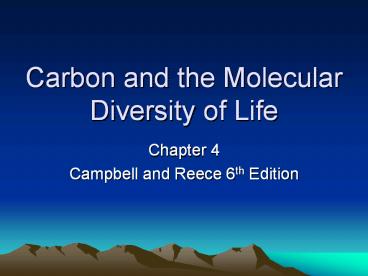Carbon and the Molecular Diversity of Life - PowerPoint PPT Presentation
1 / 18
Title: Carbon and the Molecular Diversity of Life
1
Carbon and the Molecular Diversity of Life
- Chapter 4
- Campbell and Reece 6th Edition
2
Organic Chemistry
- The study of organic compounds is called organic
chemistry. - A cell is composed primarily of
- 70-95 H2O
- C,N,O,S,P
- A Swedish chemist in the 19th century Jons Jakob
Brazelius was the first to notice that organic
compounds are found in living organisms and
inorganic substances are found in the non-living. - Scientists believed that is was impossible to
make complex organic compounds from inorganic
compounds. - Vitalism the idea that the life force was
governed by something other that chemical and
physical laws. - In 1828 a German chemist Fredrich Wohler
attempted to make an inorganic salt called
ammonium cyanate from inorganic substances but
instead made urea which is present in animal
urine. - Other scientists were not convinced because he
extracted the cyanate from living tissue. - Eventually Hermann Kolbe, a student of Wohlers
was able to make acetic acid from strictly
inorganic substances.
3
Stanley Miller
- In 1953 Miller used a laboratory simulation to
create primitive Earth. - Produced organic molecules in the laboratory
using gases present in the primordial atmosphere
like - NH3, H2O, H2 and CH4 and electricity which
simulated lightning.
4
CARBON
- Carbon is very versatile because has a 4 valence
electrons. - It has a tendency to created complex branched
molecules. - Contributes to the diversity of organic
compounds. - Hydrocarbons are
- composed of hydrogen and carbon.
- excellent fuels because the covalent bond between
the carbon and hydrogen contain a lot of energy. - composed of partially decomposed organisms.
- Hydrophobic because they are long chains of
carbon bound to hydrogen atoms.
5
Carbon to form many different chemical compounds
- 1). Length of the carbon skeleton may differ (
C-C, C-C-C, C-C-C-C-C, etc.). 2). Branching
of the carbon skeleton - ( C-C-C-C, C-C-C-C-C ) C
6
(No Transcript)
7
- 3). The number of double bonds may differ
- ( CC-C-C, CCC-C ).
- 4). The molecular structure may be in ring
form. Isomer - A chemical compound with the
same molecular formula but a different structural
formula.
8
(No Transcript)
9
(No Transcript)
10
(No Transcript)
11
Parts of Hydrocarbons are Found in Living
Organisms
12
Organic Valences
13
Types of Isomers
- Structural
- Same molecular formula but different shape.
- Geometric
- Involves a double bond in which the groups of
atoms that are covalently bound to the carbon
backbone have a different spatial arrangement. - Rhodopsin is a light induced isomer involved in
vision. - Enantiomers
- Mirror images of each other
- Thalidimide, L-Dopa and D-Dopa
14
Isomers
15
Functional Groups
- Molecular groups attached to the carbon skeleton
affect the function of the molecule. - Hydroxyl
- Carbonyl
- Carboxyl
- Amino
- Sulfhydryl (Thiol)
- Phosphate
16
Estrogen Versus Testosterone a Subtle Difference
in Function Groups
17
Estrogen and Testosterone
18
(No Transcript)

